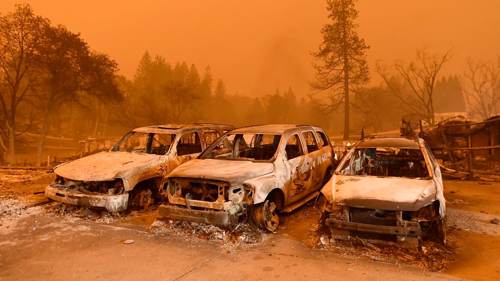Capital markets investors that participate in the ever-growing catastrophe bond and ILS space are having to rethink the wildfire peril, as its contribution to risk within multi-peril aggregate deals is on the rise, according to catastrophe risk modeller RMS.
 Conor Meenan, senior consultant in the Capital and Adjacent Markets team in London, RMS, discussed the inclusion of the wildfire risks in U.S. multi-peril aggregate deals, in light of recent and devastating outbreaks in California.
Conor Meenan, senior consultant in the Capital and Adjacent Markets team in London, RMS, discussed the inclusion of the wildfire risks in U.S. multi-peril aggregate deals, in light of recent and devastating outbreaks in California.
Multi-peril insurance-linked securities (ILS) transactions, or collateralized reinsurance, are certainly nothing new.
Initially, multi-peril deals typically included U.S. earthquake and U.S. hurricane risks, before this expanded and resulted in some transactions covering a broader set of perils in numerous regions around the world, as shown by the Artemis Deal Directory.
As noted by RMS, some catastrophe bond transactions cover a very broad set of risks under the same structure, as seen with the latest Residential Reinsurance 2018 Limited issuance from prolific ILS sponsor USAA.
This transaction, as with many of the firm’s previous issuances, offers protection against U.S. tropical cyclones, earthquakes, severe thunderstorms, winter storm, wildfire, volcanic eruption, meteorite impact, and other perils, all within the same deal.
“Building multiple perils under a single coverage makes good sense for the capital markets,” says Meenan.
Typically, multi-peril deals are structured on an annual aggregate indemnity basis, which can be especially sensitive to attritional losses from frequent perils. And, most multi-peril aggregate bonds in the cat bond market include wildfire risk as a modelled peril, says Meenan, adding that, however, the peril’s contribution to risk tends not to dominate the headline metric.
“That may now need to change,” warns Meenan, stating that although wildfire has historically been viewed as a source of attritional loss, the scale of the losses in 2017 and 2018 from the peril, is “forcing investors and issuers to rethink the potential value for wildfires to contribute significantly on an occurrence basis.”
RMS announced in November that the insurance industry loss from the Camp and Woolsey wildfires in California could reach as much as $13 billion, leading some analysts to suggest that pricing needs to change for the peril as losses break records.
In light of the scale of the recent outbreaks of wildfires, the peril has come to the forefront of industry discussions, and, 2018 witnessed the issuance of the first standalone wildfire deals to enter the ILS market.
As shown by the Artemis Deal Directory, these deals are the $200 million Cal Phoenix Re Ltd. (Series 2018-1) from PG&E Corporation, and the $125 million SD Re Ltd. (Series 2018-1) transaction from Sempra Energy.
As reported by Artemis, PG&E’s cat bond has had its secondary market price marked down heavily by brokers who suspect that the cat bond will face a significant, if not total, loss due to the ongoing wildfire outbreak.
Meenan notes that utility providers in California are responsible for insurable wildfire losses that are caused by their infrastructure, which includes business interruption and fire suppression costs. Should PG&E be held responsible for the ignition of the wildfire in Butte County, then the bond would provide a full-payout to help the firm cover its liabilities.
“If the potential impact to wildfire-only transactions isn’t enough to make investors question their current understanding of the peril, then the distressed prices of some multi-peril annual aggregate bonds and collateralized reinsurance positions certainly will,” says Meenan.
The wildfire outbreaks of 2017 and 2018 have shown that the peril can drive significant annual losses on an individual event basis, and not just on an aggregate basis.
“The need for wildfire coverage is evident, as is the appetite for multi-peril aggregate risk. Now more than ever, high-resolution loss modeling, which comprehensively captures the frequency and severity of potential impacts, is required to deepen insight and rebuild confidence in our understanding of the peril,” concludes Meenan.
Investors will certainly be considering the contribution to expected loss of perils such as wildfires in future. The catastrophe bond cover continues to broaden though, as evidenced in the latest transaction in our Deal Directory, the UnipolSai sponsored Atmos Re.
By grouping numerous severe weather related perils under a catch-all of atmospheric phenomena, the Atmos Re cat bond will effectively provide its sponsor with a source of almost all natural perils reinsurance coverage, under a single capital markets transaction.
Making it even more important that investors either understand the weather and climatic exposures they are taking on, or use a recognised specialist ILS investment manager to help them understand the risks.
 View all of our Artemis Live video interviews and subscribe to our podcast.
View all of our Artemis Live video interviews and subscribe to our podcast.
All of our Artemis Live insurance-linked securities (ILS), catastrophe bonds and reinsurance video content and video interviews can be accessed online.
Our Artemis Live podcast can be subscribed to using the typical podcast services providers, including Apple, Google, Spotify and more.































